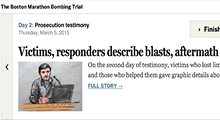When Laura Amico started at The Boston Globe this summer, she knew one of her biggest projects would be helping decide how the paper would cover the trial of Dzhokhar Tsarnaev, one of two brothers responsible for the Boston Marathon bombings.
Amico, The Globe’s data and multimedia editor, knew from experience that covering trials can be tricky. As one of the co-founders of local crime site Homicide Watch D.C., she’s aware that trials don’t always unfold in orderly narratives. Instead, they develop in fits and starts, depending on which witnesses are called and which exhibits the prosecution and defense choose to enter.
“One thing I’ve always struggled with while sitting in trials is that attorneys don’t actually build narrative,” Amico said. “They build argument. And they do it through witnesses and through the introduction of exhibits and evidence.”
The challenge, Amico said, is to create a way to track those arguments as they’re made, provide context and impose order on them. And to do all of those things in a way that delivers efficient, bite-sized pieces of information with a minimal amount of commitment from the reader.
To that end, Amico and her team have been preparing since October to adopt a structured journalism approach to covering the trial. In structured journalism, any type of story is broken down into disparate pieces of information that are saved in a database, where they can be referenced and reused later. In this case, the pieces of the story are witnesses and exhibits, which will be entered into a spreadsheet and used to track the trajectory of the arguments as they progress.
The information in the spreadsheets will be used to generate different explanatory cards, similar to the card stacks found on Vox.com, Amico said. Exhibits and witnesses entered into the database will have their own cards explaining how and when they were used in the trial and how they relate to other exhibits or witness. These cards will be updated as the trial progresses, illustrating which people and items are more important to the case relative to others.
“It’s really easy, I think, to get lost and overwhelmed in big trials, and so what I wanted to do was think about a way to help people orient themselves — not just in the moment, but in where we’ve been and where we’re headed,” Amico said.
The Globe has already debuted a version of these explanatory cards. On the homepage of Bostonglobe.com and elsewhere, Amico and her team have placed a series of timeline cards that track the events of the trial day by day. On each is a headline, a short summary of the day’s events and a link to a story that describes the arguments in greater detail.
These cards were conceived as an efficient way to give Globe readers a quick chronology of the trial they can refer back to for context as the trial unfolds, Amico said. Each card is embeddable, and a couple of news organizations plan to begin using them soon, Amico said.

One of the timeline cards that provide a daily recap of the trial.
“We’ve had some interest from national news organizations who are interested in picking them up,” Amico said. “What I was thinking about when we started moving in that direction was that The Boston Globe had just incredible, incredible resources to cover this trial. And that we’d like to share as many of those resources with as many people as we can.”
Each timeline card also doubles as an audio player for “Finish Line,” a podcast on the events of the trial by The Boston Globe and public radio station WBUR. The podcast, which is hosted by Globe columnist Kevin Cullen and WBUR senior reporter David Boeri, is aimed at providing readers with the auditory equivalent of a seat in the courthouse — an intimate back-and-forth that captures the color, emotion and tiny details that might be excluded from a straightforward news report.
“If they were able to be there, and if they were to sit between Kevin and David, we want to capture some of the conversation that they might overhear,” Amico said.
The biggest hurdle in developing a coverage plan for the Tsarnaev trial was figuring out a cohesive design for the cards, Amico said. The designer for the project went through several drafts trying to strike a balance between too much information and not enough. An early timeline feature was deemed to be too distracting and cut from the final product in order to create a more concise chronology.
Amico expects the trial will last about six months, during which time The Globe will continue its daily recaps of the trial, Amico said. So far, most of The Globe’s audience has been focused on the paper’s live blog and daily stories, but Amico thinks the paper’s other digital offerings will become increasingly relevant to readers as the trial progresses.
“Realizing that this moment is more to us than opening statements, and it continues through closing statements, the need that we’re trying to address is what happens in those in-between times,” she said, “and how to make sense of them.”






